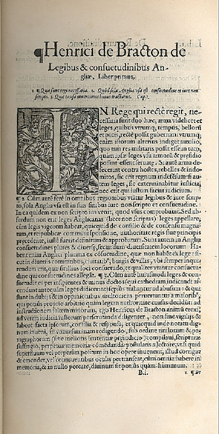(Bracton on the Laws and Customs of England
attributed to Henry of Bratton, c. 1210-1268)
About the Man
Henry of Bratton (Henricus de Brattona or Bractona) was an English judge of the court known as coram rege (later King's Bench) from 1247-50 and again from 1253-57. After his retirement in 1257, he continued to serve on judicial commissions. He was also a clergyman, having various benefices, the last of which being the chancellorship of Exeter cathedral, where he was buried in 1268.

The first printed edition of Bracton
published in London in 1569.
Click image for more information
About the Work
Bracton's chief claim to fame is his association with the long treatise De legibus et consuetudinibus Angliae (On the Laws and Customs of England), which the noted legal historian F.W. Maitland described as "the crown and flower of English jurisprudence." The work (commonly known now simply as Bracton) attempts to describe rationally the whole of English law, a task that was not again undertaken until Blackstone's Commentaries on the Laws of England in the eighteenth century. The work is remarkable both for its wealth of detail and for its attempts to make sense out of English law largely in terms of the ius commune, the combination of Roman and canon law that was taught in the universities in Bracton's time.
While the attribution of the work to Bracton is of considerable antiquity, it now seems that the bulk of the work was written in the 1220's and 1230's by persons other than Bracton himself. It seems then to have been edited and partially updated in the late 1230's, with various additions being made to it between that time and the 1250's. The last owner of the original manuscript and the author of the later additions was probably Bracton.
About the Project
We reproduce here the Latin text of George Woodbine (1876-1953) with the translation of the late Samuel E. Thorne (1907-1994). To Professor Thorne we owe the modern understanding of authorship of the work. A brief account (from which the above is derived) of Bracton by J.H. Baker may be found in A.W.B. Simpson (ed.), Biographical Dictionary of the Common Law, s.v. Bracton. Bibliography since Thorne's work includes: J.L. Barton, "The Mystery of Bracton," Journal of Legal History, 14 (1993) 1-142; P.A. Brand, in J. Hudson (ed.), The History of English law: Centenary Essays on "Pollock and Maitland."

Samuel E. Thorne's critical edition of Bracton, with both the Latin and English translation. Click image for more information
To achieve this electronic version we sent the Thorne volume to a professional keying house and had the volume double-keyed. With this process, two separate keyers re-type the entire volume, the two versions are compared, and any differences are noted and corrections made.
The HTML used in the two electronic versions of Bracton is generated from SGML text tagged according to the TEI-Lite standard. We found TEI-Lite relatively easy to apply to the problems of encoding Thorne's edition (though in the case of such peculiar Thorne-isms as spanned footnotes we had to stretch our minds -- and the standard -- a bit). In this iteration we tagged only those features which could be easily identified by persons with no special knowledge of Bracton or of Latin, and we have not inserted much of the standard TEI header information into the SGML source files.
Most of the tagging was done by the keying house. We did identify some highly repetitive and easily automated tagging which could be omitted from the spec given to the keying house; this was a cost saving measure, as we were paying by the keystroke. This tagging was later inserted via a simple Perl script, and included such things as adding an explicit <LB> tag for each line break (we had asked the keying house to preserve but not tag these), and adding the PLACE=FOOT attribute for all the notes. One drawback of having the keying house do all of the tagging was that we were limited to tagging those features which could easily be identified by people unfamiliar with Bracton. Nevertheless, this approach was (as you can see) sufficient to reproduce and enhance the functionality of the printed edition while providing a solid base for further work by specialists. More information regarding the technical aspects of Bracton Online can be found on the search page.
This electronic version is a co-production of the Ames Foundation, the Harvard Law School Library, and the Legal Information Institute, Cornell Law School. The principals involved in its construction were Professor Charles A. Donahue of the Harvard Law School and Thomas R. Bruce of the Legal Information Institute. Terry Martin of the Harvard Law School Library provided significant support and facilities for the project. We are indebted to numerous others for advice and assistance.
Copyright Information
English translation
Copyright (c) 1968-1977 by the President and Fellows of Harvard College.
Latin text Copyright (c) 1922-1942 by Yale University Press.
Javascript presentation software, CGI scripts, and text-conversion software
Copyright (c) 1998, Legal Information Institute, Cornell Law School.
Contact us
We welcome your suggestions for improving the collection, and we are very interested in obtaining information about its use by teachers and scholars. We encourage you to get in touch with us at the e-mail address below.
Page last reviewed April 2003.
© 2003 The President and Fellows of Harvard College
